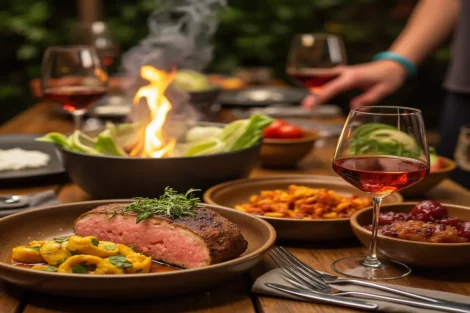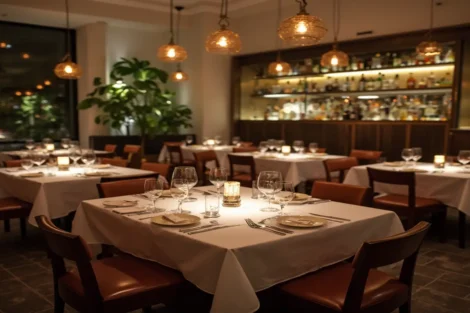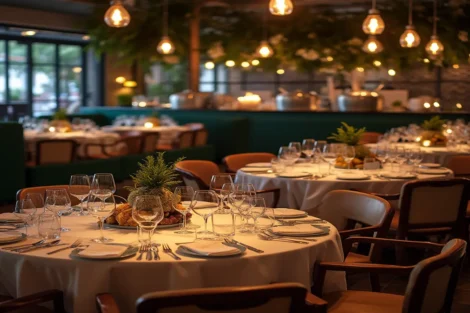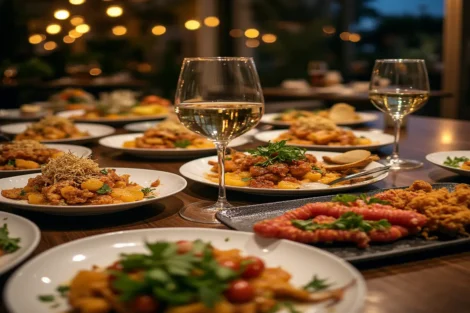Miami is home to a vibrant and diverse culinary scene that offers a wide range of dining experiences. Whether you’re seeking beachfront vibes, world-class cuisine, or a fun, interactive atmosphere, here are some categories of dining experiences you can enjoy in Miami:
1. Waterfront Dining
- Juvia (Miami Beach): Rooftop restaurant with stunning views of the city and ocean. Known for its fusion of French, Japanese, and Peruvian cuisine.
- The Rusty Pelican (Key Biscayne): Iconic for its spectacular skyline views and fresh seafood.
- Smith & Wollensky (South Pointe Park): Classic steakhouse with outdoor seating overlooking the water.
2. Latin and Caribbean Flavors
- Versailles (Little Havana): The go-to spot for Cuban comfort food like ropa vieja and Cuban sandwiches.
- La Mar by Gastón Acurio (Brickell Key): Upscale Peruvian dining featuring ceviches and pisco cocktails.
- Bakan (Wynwood): Modern Mexican cuisine with handmade tortillas and mezcal-focused drinks.
3. Trendy & Upscale Experiences
- Carbone (South Beach): Glamorous Italian-American spot with a retro vibe.
- Papi Steak (South Beach): A high-energy steakhouse with a chic and intimate ambiance.
- KYU (Wynwood): Asian-inspired dishes with a focus on wood-fired grilling.
4. Casual and Unique Eats
- Joe’s Stone Crab (South Beach): A Miami institution for fresh stone crab claws, casual but legendary.
- The Salty Donut (Wynwood): Known for its artisanal donuts and creative flavors.
- La Sandwicherie (South Beach): A French-inspired sandwich shop popular for its fresh ingredients and signature vinaigrette.
5. Experiential Dining
- Casa Tua (Miami Beach): A romantic Italian villa-style setting with hidden garden dining.
- Strawberry Moon (The Goodtime Hotel): Combines dining with poolside glamour and nightlife.
- Barton G. (South Beach): Known for over-the-top food presentations, like cocktails served with dry ice.
6. Nightlife and Dinner
- Komodo (Brickell): Combines upscale Asian dining with a lively lounge atmosphere.
- Baoli (South Beach): Transforms into a party scene post-dinner with DJs and dancing.
- Sexy Fish (Brickell): Dazzling décor, seafood-forward menu, and a high-energy vibe.
Tips for Dining in Miami
- Reservations: Many popular spots fill up quickly, especially on weekends. Plan ahead!
- Dress Code: Upscale venues often have a dress code—smart casual or elegant.
- Seasonal Ingredients: Look for restaurants that highlight local, seasonal seafood and produce.
Table of Contents

What are the dishes served for dinner in Miami restaurants?
Miami restaurants offer a wide range of dishes influenced by its diverse cultural heritage, including Latin American, Caribbean, European, and Asian cuisines. Here are some popular dishes you can find for dinner at Miami restaurants:
Seafood Specialties
- Stone Crab Claws: A Miami classic, especially during stone crab season (October to May).
- Grilled Snapper or Mahi-Mahi: Freshly caught local fish served with tropical salsas or citrus marinades.
- Ceviche: A refreshing dish of marinated raw fish, often served Peruvian-style with corn and sweet potato.
- Seafood Paella: Spanish-inspired rice dish loaded with shrimp, mussels, clams, and saffron.
Latin and Caribbean-Inspired Dishes
- Ropa Vieja: Shredded beef stewed in a rich tomato-based sauce, typically served with rice and plantains.
- Cuban Sandwich: Ham, roasted pork, Swiss cheese, pickles, and mustard pressed in Cuban bread.
- Lechón Asado: Slow-roasted pork marinated with citrus and garlic, a Cuban favorite.
- Tostones and Maduros: Fried green or ripe plantains served as sides or appetizers.
- Mofongo: Mashed plantains with garlic and pork cracklings, often topped with shrimp or chicken.
Steaks and Grilled Meats
- Churrasco: Grilled skirt steak, usually served with chimichurri sauce.
- Argentinian Parrillada: A mixed grill featuring various cuts of meat, sausages, and sometimes grilled vegetables.
- Picanha: A popular Brazilian-style cut of beef cooked on skewers.
- Ribeye or Filet Mignon: Premium cuts of beef served at Miami’s high-end steakhouses.
Italian and Mediterranean Dishes
- Lobster Ravioli: Fresh pasta stuffed with lobster and served with creamy or tomato-based sauces.
- Branzino: Mediterranean sea bass, often grilled and seasoned with herbs and lemon.
- Octopus a la Plancha: Grilled octopus with olive oil and garlic.
- Wood-Fired Pizza: Authentic Italian-style pizzas with gourmet toppings.
Asian-Inspired Favorites
- Peking Duck: Crispy roasted duck served with pancakes, hoisin sauce, and scallions.
- Sushi and Sashimi: Freshly prepared rolls and raw fish, often with tropical or spicy twists.
- Korean BBQ: Interactive dining experience where diners grill their own meats and vegetables at the table.
- Pad Thai or Thai Curries: Popular Thai dishes with vibrant flavors of coconut milk, lime, and chili.
Vegetarian and Plant-Based Options
- Tropical Buddha Bowls: Grain-based bowls with tropical fruits, avocado, and roasted vegetables.
- Vegan Tacos: Made with jackfruit, plant-based proteins, or roasted veggies.
- Cauliflower Steak: Thick-cut cauliflower grilled or roasted with flavorful spices.
Desserts to End the Meal
- Key Lime Pie: A must-try, this Florida specialty combines a tangy lime filling with a graham cracker crust.
- Tres Leches Cake: A sponge cake soaked in three kinds of milk, popular in Latin-inspired restaurants.
- Churros: Crispy fried dough served with chocolate or caramel dipping sauces.

How do I choose the best restaurant in Miami?
Choosing the best restaurant in Miami depends on your preferences, occasion, and dining goals. Here’s a step-by-step guide to help you make the right choice:
1. Define Your Preferences
- Cuisine: Decide what type of food you’re craving (e.g., seafood, Latin, Italian, Asian).
- Ambiance: Do you prefer a casual eatery, a romantic setting, or a lively atmosphere?
- Location: Consider whether you want a beachfront view, a spot in trendy Wynwood, or something in Downtown Miami.
2. Consider the Occasion
- Romantic Date: Look for intimate settings with great ambiance, like Casa Tua or Juvia.
- Family Dinner: Choose family-friendly spots with diverse menus, such as Joe’s Stone Crab or La Mar.
- Special Celebration: Opt for unique experiences like Barton G. (for theatrical dishes) or Komodo (for upscale dining and nightlife vibes).
3. Research Reviews
- Online Platforms: Check reviews and ratings on Google, Yelp, or TripAdvisor to gauge food quality, service, and atmosphere.
- Social Media: Search for restaurants on Instagram or TikTok to see real-life photos and videos of dishes and ambiance.
- Local Recommendations: Ask locals or friends who’ve visited Miami for their favorite spots.
4. Look at the Menu
- Check the Offerings: Ensure the menu aligns with your preferences and dietary restrictions.
- Price Range: Review the menu prices to ensure they fit your budget.
- Signature Dishes: Research what the restaurant is famous for and decide if it’s something you’d enjoy.
5. Make Reservations
- Popular Spots: Many top-rated restaurants in Miami get fully booked, especially on weekends and during high season.
- Call Ahead: If reservations aren’t available online, call the restaurant directly to confirm availability.
6. Consider Unique Experiences
- Waterfront Dining: If you want a scenic view, choose places like The Rusty Pelican or Smith & Wollensky.
- Live Entertainment: Some venues, like Baoli or LIV, combine dining with nightlife.
- Chef-Driven Menus: For foodies, explore restaurants led by renowned chefs, like Stubborn Seed (Jeremy Ford) or Los Fuegos (Francis Mallmann).
7. Dietary Preferences
If you or your dining companions have dietary needs, such as vegan, gluten-free, or keto, ensure the restaurant can accommodate them. Many Miami establishments highlight such options on their menus.
8. Go Local
For a truly authentic experience, visit restaurants that showcase Miami’s unique flavors, such as:
- Cuban Cuisine: Versailles or La Carreta.
- Peruvian Favorites: Cvi.Che 105 or La Mar.
- Seafood Specialties: Garcia’s Seafood Grille or Joe’s Stone Crab.
Pro Tips
- Timing: Dine early to avoid crowds and enjoy quieter surroundings.
- Special Deals: Check for happy hour specials or prix fixe menus for value dining.
- Seasonal Trends: Explore newly opened restaurants or those featured during Miami Spice (a seasonal dining event).

In which season of the year is the dining experience at Miami restaurants the best?
The dining experience at Miami restaurants is generally enjoyable year-round, but certain seasons enhance the experience due to weather, local events, and seasonal ingredients. Here’s a breakdown to help you decide the best time to dine in Miami:
1. Winter (December to February)
- Best For: Outdoor dining and waterfront experiences.
- Why It’s Great:
- The weather is mild, with comfortable temperatures perfect for al fresco dining at restaurants with patios or rooftop views.
- High season for tourists, so there’s a lively atmosphere in many restaurants.
- Seasonal dishes often include fresh seafood, including stone crab claws.
- Things to Note:
- Restaurants can be busier and reservations are essential during this time.
2. Spring (March to May)
- Best For: Enjoying fresh seasonal ingredients.
- Why It’s Great:
- Pleasant weather continues, with slightly warmer temperatures compared to winter.
- Spring menus often feature fresh fruits, vegetables, and seafood.
- Miami Beach is vibrant, making it a great time to visit trendy spots in South Beach or Wynwood.
- Things to Note:
- Spring break crowds might make some areas busier, but this also adds to the energy of the city.
3. Summer (June to August)
- Best For: Deals and casual dining.
- Why It’s Great:
- Miami Spice event often starts in August, offering prix fixe menus at top restaurants at discounted prices.
- Quieter period in some high-end restaurants, allowing for a more relaxed dining experience.
- Tropical flavors and refreshing dishes, like ceviche and cold desserts, are popular.
- Things to Note:
- Hot and humid weather means indoor dining with air conditioning is more comfortable.
- Afternoon rain showers are common, so plan accordingly if dining outdoors.
4. Fall (September to November)
- Best For: Value dining and culinary events.
- Why It’s Great:
- Miami Spice continues through September, providing more opportunities to try upscale restaurants affordably.
- Crowds are smaller as it’s a shoulder season for tourism, making it easier to get reservations.
- Cooler weather begins to return in November, making outdoor dining pleasant again.
- Things to Note:
- Some restaurants might have shorter hours or limited menus during the early fall offseason.
Overall Recommendation
The winter season (December to February) offers the best overall dining experience due to the ideal weather, lively atmosphere, and availability of iconic Miami dishes like stone crabs. However, summer and fall are excellent for food enthusiasts looking to explore Miami’s top restaurants at more affordable prices.
What is the difference between fast food places and restaurants in Miami?
The main differences between fast food places and restaurants in Miami (and elsewhere) lie in the type of food, service style, ambiance, price range, and overall experience. Here’s a detailed comparison:
1. Food Quality and Preparation
- Fast Food Places:
- Serve quick, ready-to-eat meals like burgers, fries, pizza, and sandwiches.
- Focus on convenience and speed over gourmet preparation.
- Typically offer standardized menus with limited customization.
- Examples: McDonald’s, Burger King, Taco Bell, Pollo Tropical.
- Restaurants:
- Provide a broader menu with dishes often prepared fresh, including gourmet and specialty options.
- Ingredients may be higher quality and locally sourced, with a focus on presentation.
- Cater to specific cuisines (e.g., Italian, Japanese, Cuban, or seafood).
- Examples: Joe’s Stone Crab, La Mar, Carbone.
2. Service Style
- Fast Food Places:
- Self-service or counter-service. You order at the counter or drive-thru, and food is delivered quickly.
- Minimal interaction with staff.
- No table service; customers usually clean up after themselves.
- Restaurants:
- Full-service dining, where staff take your order, serve food at the table, and clear dishes.
- More personalized attention, including wine pairings or dish recommendations.
- Higher emphasis on customer service and creating a welcoming atmosphere.
3. Ambiance
- Fast Food Places:
- Casual and often utilitarian design focused on functionality.
- Limited focus on décor or comfort, though some chains offer modern, clean interiors.
- Fast-paced environment with quick turnover of customers.
- Restaurants:
- Varied ambiances, ranging from casual and cozy to upscale and elegant.
- Focus on creating a memorable dining experience with décor, music, and lighting.
- May include waterfront views, rooftop settings, or themed interiors.
4. Price Range
- Fast Food Places:
- Budget-friendly options, with meals typically costing $5–$15.
- Focus on affordability and value meals.
- Restaurants:
- Prices vary widely but are generally higher than fast food. Meals may range from $20 to over $100 per person, depending on the venue.
- Fine dining establishments charge a premium for ambiance, service, and high-quality ingredients.
5. Time Commitment
- Fast Food Places:
- Designed for quick meals, typically under 30 minutes.
- Perfect for people on the go or looking for a fast, convenient option.
- Restaurants:
- Dining is often a leisurely experience, with meals lasting an hour or more.
- Encourages savoring food and socializing with others.
6. Target Audience
- Fast Food Places:
- Cater to people seeking convenience, affordability, or a quick bite.
- Popular among families, travelers, and busy professionals.
- Restaurants:
- Attract those looking for a more refined dining experience, special occasions, or diverse culinary offerings.
- Ideal for date nights, celebrations, or food enthusiasts.
7. Customization and Variety
- Fast Food Places:
- Offer limited customization (e.g., “add extra cheese” or “no pickles”).
- Focus on a consistent menu across locations.
- Restaurants:
- Offer more variety and the ability to customize dishes based on preferences or dietary needs.
- Often provide seasonal or chef-special menus.
In Miami, both fast food places and restaurants thrive due to the city’s fast-paced lifestyle and diverse culinary culture. Whether you’re grabbing a quick bite at Pollo Tropical or enjoying a luxurious dinner at Juvia, the choice depends on your time, budget, and dining preferences.
Should I choose the restaurant with the most reviews?
Choosing a restaurant based solely on the number of reviews can be helpful but isn’t always the best strategy. Here’s a guide to help you decide if a restaurant with the most reviews is the right choice:
Why Restaurants With Many Reviews Are Worth Considering
- Popularity: A high number of reviews often indicates that the restaurant is popular and well-visited, which can be a good sign of its quality and consistency.
- Reliability: With many reviews, you’re likely to find a more accurate overall picture of the dining experience, including food, service, and ambiance.
- Trending Spots: If you’re looking for a trendy or highly recommended place, restaurants with the most reviews are often well-known in the community.
Why You Shouldn’t Rely Solely on Review Count
- Quality vs. Quantity:
- Some restaurants might have many reviews but average or mixed ratings, indicating that they are not consistently excellent.
- Smaller or newer restaurants may have fewer reviews but provide exceptional food and service.
- Tourist-Focused Spots:
- Highly reviewed restaurants may cater primarily to tourists and offer a generic experience, while hidden gems frequented by locals might have fewer reviews.
- Review Content Matters:
- The quality of the reviews is more important than the quantity. Look for detailed reviews that mention specifics like the quality of the food, cleanliness, service, and ambiance.
- Watch for red flags like repeated complaints about poor service or food quality.
How to Choose the Best Restaurant
- Check the Ratings:
- Look for restaurants with both high ratings (4+ stars) and a significant number of reviews for reliability.
- Read Recent Reviews:
- Focus on the most recent reviews to ensure the restaurant still meets expectations. Older reviews may not reflect current conditions.
- Consider Your Preferences:
- A restaurant might have many reviews for a type of food you’re not interested in. Choose based on your taste, budget, and dining goals.
- Look for Specific Highlights:
- Find out what the restaurant is known for (e.g., a signature dish, unique ambiance, or excellent service).
- If multiple reviews mention the same standout qualities, it’s likely worth trying.
- Use Filters:
- Platforms like Yelp, Google, or TripAdvisor often allow you to filter reviews by keywords like “family-friendly,” “romantic,” or “vegetarian options.”
When to Choose the Restaurant with the Most Reviews
- If you’re in an unfamiliar area and want a reliable, popular choice.
- When seeking a lively or well-known spot with a high turnover of guests.
- For casual dining or if you’re flexible with your expectations.
When to Explore Lesser-Known Options
- If you prefer quieter, more intimate settings or unique, off-the-beaten-path experiences.
- When you’re seeking authentic, local cuisine that might not cater to tourists.
In short, the restaurant with the most reviews can be a good starting point, but it’s essential to dig deeper into the reviews and consider your preferences. If you’re unsure, let me know what you’re looking for, and I can help you decide!

